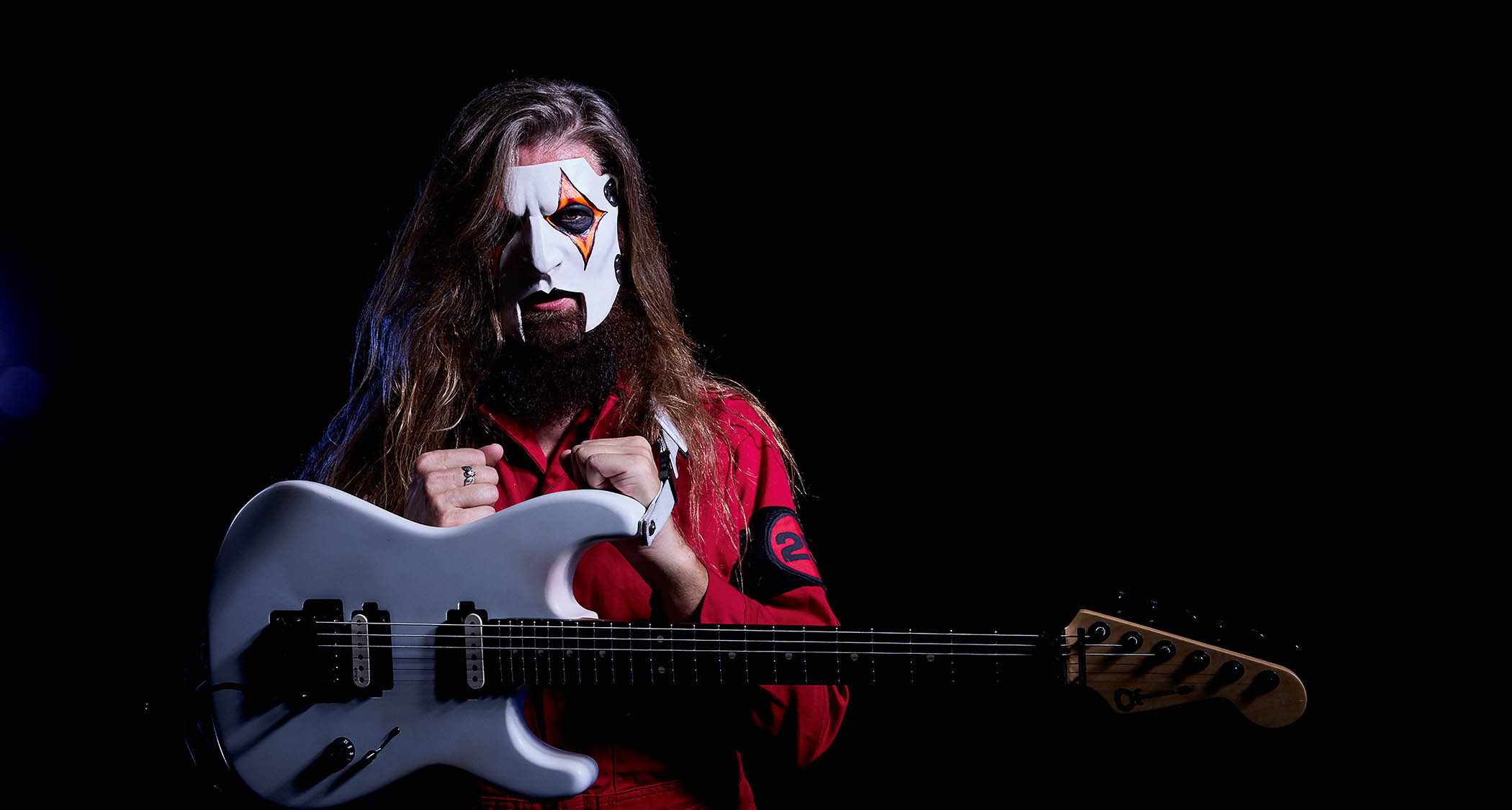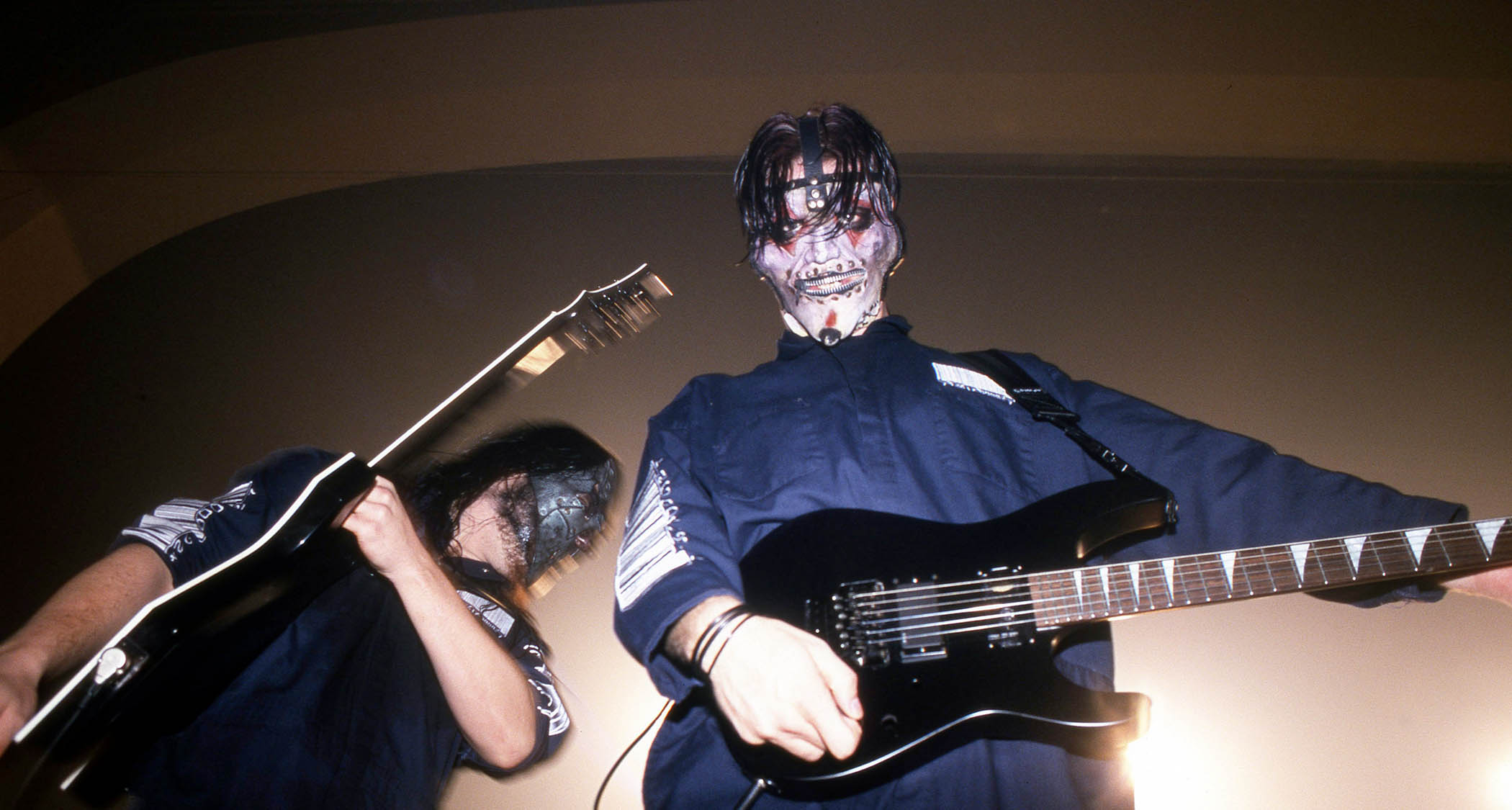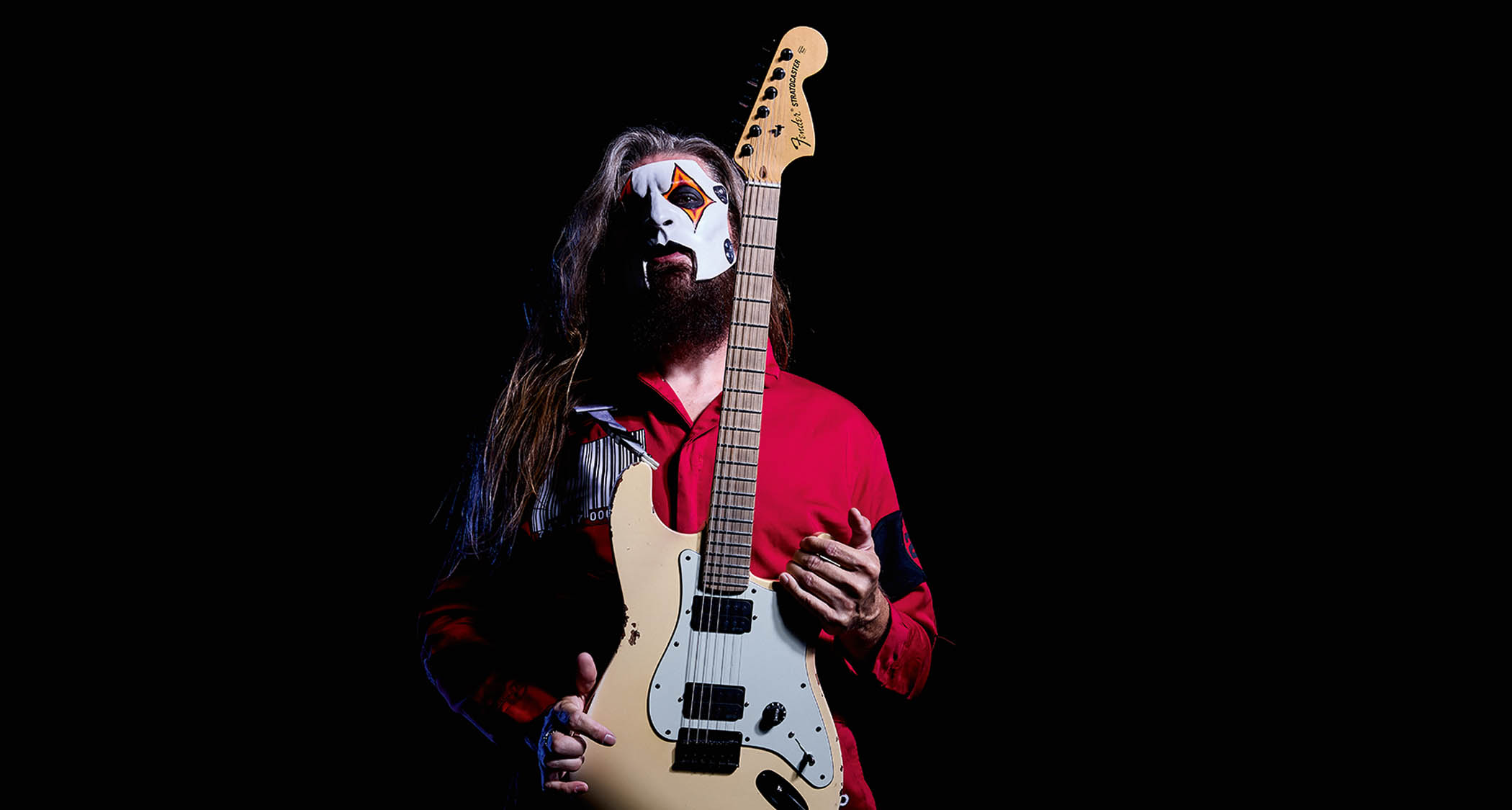
He was the last man in. When guitarist Jim Root joined Slipknot in the first months of 1999, the band were in the final stages of recording the debut album that would define them as the dominant new force in metal.
Root’s arrival came so late in the day that he played on just one track, Purity. The rest of the Slipknot album had been recorded with guitarists Mick Thomson and Josh Brainard prior the latter’s departure from the band.
But with Root in the fold, adopting his predecessor’s number 4, the puzzle was complete. This version of the nine-man band turned out to be the definitive Slipknot line-up, featuring on three more albums – 2001’s Iowa, 2004’s Vol.3: (The Subliminal Verses) and 2008’s All Hope Is Gone – that established the ’Knot as a global superpower.
And while there have been various personnel changes since then, the two-guitar axis of Thomson and Root has remained at the core of the band’s skull-throbbing sound.
Throughout all these years, Jim has kept on mixing it up guitar-wise – brandishing anything from Jackson Dinkys, Charvels and, of course, his signature Fender Teles, Strats and Jazzmasters en route to creating a crushing tone. But now, as he prepares for a tour celebrating the 25th anniversary of that legendary debut album, he’s been digging out some of the discount shred guitars he hasn’t played since way back in the day.
As he tells Total Guitar: “I’ve been playing around with some oddball guitars that I don’t normally play, like DKs and Charvels. I brought some old guitars out that are like 16 or 17 years old, and I’ve loaded them with my pickups, and set them up for how I like them. There’s two PRS guitars I want to bring out for this tour, and two old Jacksons from the early 2000s…”
As he discusses all the ins and outs of his gear journey with Slipknot, Jim also considers where he’s headed in the future. But he begins by taking us all the way back to those heady days of 1999, when the tools at his disposal were basic to say the least…
I think I got an Ibanez 5-something series, and the neck kept moving on it… I hated all the gear I had then!
What did your rig look like when you joined Slipknot?
“When I first joined Slipknot, I think all I had was a Mesa/Boogie .50 Caliber [Plus 2-Channel], which I still have. I had that with a road-ready cabinet, and then I had a ’93 Strat with a Lace Sensor Gold pickup in it because I was really trying to go back to a humbucker, metal kind of guitar. And I think I got an Ibanez 5-something series, and the neck kept moving on it… I hated all the gear I had then!”
Did you know what you were looking for as you began to sculpt your tone?
“In the early days, I was just trying to figure things out. I had never used EMGs before. I’d always used whatever pickups the guitar came with because I couldn’t really afford to swap them out, and I didn’t work at a guitar shop or anything. But when I joined Slipknot, it was like, ‘Hold on… I’m in this band that’s a little bit heavier on the guitar side. I need something a little bit hotter.’”
Did Mick give you any advice to guide your hand?
“I needed something that would cut through because there were way more members in the band, and they tuned lower, a few steps down from what I was used to, and then they were dropping that tuning on top of that. So I was getting tips from Mick. I was like, ‘What gauges of strings do you use?’ I was copying his string gauges. We’d be getting them from the shop at the same time.”
When did the EMGs officially come into play for you?
“I got a set of EMGs put in a Jackson Dinky DK that I had with a green flametop, satin hardware, and a reverse headstock. I put an 81 and an 85 in that guitar, and that was really what I was using. And once we started touring more and gaining more notoriety, I was able to play with the gauges and come up with what I preferred for that low tuning. And depending on what guitar I was using, it evolved from there.”
I was trying to find consistent guitars that were built well enough that I wouldn’t be adjusting them every time I took them out of the case
Specifically, what did that evolution look like in terms of guitars?
“On the guitar side, I was trying to find consistent guitars that were built well enough that I wouldn’t be adjusting them every time I took them out of the case in a different city. I needed guitars built well enough that the frets wouldn’t start popping out since we were throwing them in the case and putting them in a big trailer pulled by a bus!”
And how about your amps?
“After I recorded what I did for the first record and then the Iowa record, I borrowed a Laney Pro Tube Lead Series, which was modded. I really liked the sound of that. It blended and mixed really well, so I chased that tone down for a little bit, trying to find amps that basically had the same characteristics. But I was so used to my .50 Caliber Boogie, and Mesa/Boogie were cool enough to send a couple of DC-10s that they were discontinuing.”
But you didn’t settle on those for long.
“I used those DC-10s for a while and tried using them in the studio, but they just weren’t cutting it. That’s when I really dived into trying out as many different amp companies as I could. I was like, ‘I’m just going to revolve these and find the one that not only works best in the studio but holds up live and is roadworthy.’ There’s a balance of what you like personally, the tone that works best for the band, and what doesn’t need to be taken apart and re-tubed every week.”
You eventually settled on Orange amps. What moved the needle there?
“I went to a NAMM show, and they had the Rockerverb series. I went to the Orange booth and just picked up the guitar they had there – which had single-coils. I plugged it into this amp, and it had gain for days. It sounded really snarly and had this midrange grunt.
“It had all the characteristics that I thought were awesome and would cut through, and I really dug the way the speaker sounded with the wicker in the front. Orange is really known for a stoner rock, doom, Black Sabbath vibe, but I said, ‘I’m gonna make this work because there’s a real midrange Marshall vibe that I like.’”

As you alluded to earlier, a big part of your tone came down to string gauges, which you copied from Mick. You also mentioned you began to play around with that more as you went on.
“That’s a tough one because each guitar has a different feel. With low tunings it can’t be slinky, but I feel like my [Dunlop] Drop B set is really slinky in comparison to what some people use when they tune that low. My lowest string is only a .56, but there are dudes out there that are using .60s. I wanted to keep it as tight as I could with the tension of the strings, but also be slinky enough to be doing bends and running scales and shit.”
There’s two pedals on my ’board that I’ve had forever: the Jimi Hendrix Octavio, which is friggin’ awesome for octave fuzz kinds of things. And then I always have a Carbon Copy Delay
Through all that, what did the evolution of your ’board look like?
“In the beginning, I was basically only using a wah just to give certain parts a bit of colour. There are certain parts of songs where it’s nice to put a little something on there. I’d even use a phaser just to give some wetness or something a little different. And I was using a Univibe for a while for some weird, almost crazy, filtered, wobbly noises.
“But honestly, there’s two pedals on my ’board that I’ve had forever: the Jimi Hendrix Octavio [JH-OC1], which is friggin’ awesome for octave fuzz kinds of things. And then I always have a [MXR] Carbon Copy Delay, too. It has a nice warmth to it, and you can also play with the speed where you hit a note, then you can adjust the warble around and make it repeat itself like a synthesizer.”
You were mainly using Jackson guitars and even some PRS guitars early on, so what led you astray?
“That was kind of unusual because Fender was giving me a Flat Head [Telecaster], so I was kind of endorsed by the Custom Shop, and I had two or three Flat Head Teles, and I love those guitars, they were very roadworthy. And then Fender acquired Charvel, and they made me a couple of prototypes because I was talking about going to Charvel for a bit and doing a signature model with them.”
Is that what led to your signature Telecaster?
“The Charvels weren’t quite what I wanted, even though I loved the way they play. Since then, the quality has come a long way. Now, they’re really well-done guitars. But anyway, my guy at Fender was like, ‘Yeah, you can come back. Though we’re going to do a Tele.’ And I was like, ‘I’m into it. I’m down for that.’ So, that’s when we started working on the specs for the original Jim Root Tele all those years ago.”
And then came your signature Jazzmaster, a guitar that most people don’t associate with heavy music.
“You know, I’m always looking for things to piss off metalheads! And apparently, also piss off Jazzmaster and Tele players! But, I mean, it’s a slab of wood with pickups and strings, you know? Who gives a shit about the shape of the guitar? Fender sent me a Jazzmaster years before we talked about doing a signature model, and I really didn’t play it that often. I thought it was kind of awkward-looking.”
What changed your mind?
“I played it sitting down a few times, and it played really well. And it sounded really good, but I didn’t think about it much. And then we were doing pre-production on something and I put one of my straps on it so I could stand up and play, and I was like, ‘Holy shit! This guitar is just so well-balanced.’
“It felt so comfortable and easy to play because it was right in the pocket. So I hit Fender back up and was like, ‘I know you sent me this Jazzmaster a while ago, and I haven’t given you any input or talked about it, but I’m using it at rehearsal, and I’m loving it. It’s kind of awesome’. Hey said, ‘Cool. Do you want to do a signature model?’ And I was like, ‘Yes!’”
Since you started using proper shred guitars, have Teles and Jazzmasters changed how you play?
“No. Well, maybe a little bit. When you first pick up a Tele or a Jazzmaster, you’re not sitting there thinking about doing neoclassical scales or shredding per se. But the more you play them, the more you start doing that kind of stuff. And then if you play the songs that are in your set that do have solos, it’s like, ‘Wow! They kind of rip!’
“Even a Gretsch Country Gentleman, the neck profiles on those things are nice and thin, and it’s the same with Jazzmasters. I’ve seen videos of [country music star] Roy Clark from back in the ’60s with a Jazzmaster, and he’s tearing it up!”
But now, with Slipknot celebrating the 25th anniversary of that mighty debut album, you’re pulling your old Jackson and PRS guitars out of mothballs.
“I tell my tech, ‘Just surprise me with what you’re gonna give me tonight – I don’t care what guitar it is, let’s mix it up a little bit and just play around’.”
Has it been fun to have those guitars on stage again?
“He’ll hand me a guitar, and sometimes, I’m like, ‘Whoa, I forgot about this guitar! Cool!’ So it’s kind of fun to do. I have these guitars that I used back around the time we were playing on and touring the first album. I still have a few lying around that I haven’t gotten rid of. It’s fun to do since we’re kind of doing this throwback thing, so I said, ‘I might bring some of these guitars with me.’”

And the word is you’ve finally given amp modellers a go.
“Yeah, I kind of took the plunge against my own better judgment and have been using the [Neural DSP] Quad Cortex for some shows, which, you know, is somewhat sacrilegious. I know I’ve told people I would never do that, but here I am, doing that! It’s been working really well, but I feel like something’s missing, so no matter how advanced the technology gets with digital, it’s still fatiguing to the ears because we’re analogue beings.”
I kind of took the plunge against my own better judgment and have been using the Quad Cortex for some shows, which, you know, is somewhat sacrilegious
Given that you’re a tube amp purist, was it just curiosity that pushed you in this direction?
“I’ve been using the Quad Cortex just for its effects along with my heads for a few tours, but we’re talking about doing smaller, secret shows, and the thing with doing that is we’ve got to downsize. So, part of it came out of the necessity of trying to figure that out without losing the effects we use in the studio and making things translate live, which is hugely important.”
Is a signature Jim Root Quad Cortex or modeling unit in the cards?
“I don’t think so. I don’t think I’d go that far. I’d like to work on it a little bit more and see what we can come up with for a rack system with a rack-mounted preamp. And I love my Oranges. I still have all my touring racks and my Orange heads. So, I’m still a tube purist. I still believe that’s the best way. It’s just a matter of making it work when we consider the smaller venues, even if it means taking a half-stack. They take up a lot of stage, you know? It’s a battle.”
I’m still a tube purist. I still believe that’s the best way. It’s just a matter of making it work when we consider the smaller venues
You were singing the praises of a recently purchased hardtail Strat on Instagram. Is that a precursor to your next signature guitar with Fender?
“I would love to. If Fender were down for a version two of my Strat, I would be all about that. But I think I’m maybe a little oversaturated with the signature models now. I have a custom Jackson built that’s kind of based on the Virtuoso series, too. But I would love to do another version of my Strat. If I did, I would probably do it with a Floyd [Rose], like the guitars I’ve been playing lately.”
You’ve come a long way on your gear journey, so what’s your best piece of advice for those who are starting out?
“That’s a tough one because you can go down rabbit holes with this stuff, and you can end up spending thousands of dollars. Reverb is my enemy! It’s hard when you’re sitting around bored at night. That’s how I ended up with this DK Jackson.
“I’d say to maybe get some sort of modeling app to see what type of effects you’d use the most. And then, if you want to become a purist, base your amps and pedalboard off what you are using on one of those modeling things.
“Maybe you’ll end up spending less in the long run, but I don’t know… It’s always cool getting new shit, especially new shit that blows your mind, or when you’re using things in a way that’s maybe not how they’re intended to be used can be fun sometimes, or it can just be really fucking noisy!”
- See Slipknot for upcoming dates and ticket details.







